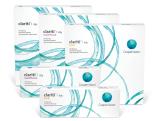You may have heard of the term “silicone hydrogel,” but not fully understood what it means in relation to contact lenses. If so, you’re not alone.
We’re here to help you understand what this means in the world of contacts.
Over time, the technology in manufacturing products tends to improve. Contact lenses are no different. They improve over time, too—allowing us to wear them longer with more comfort. Part of this advancement is due to the use of silicone hydrogel.
We’ll explain.
What does “silicone” mean here?
“Silicone,” not “silicon” plus an “e,” is a polymer, a chemical compound. If that sounds Greek to you, you’d be right! It is.
We can translate the word to mean “many parts,” and that’s exactly what polymers are—chemical compounds coming together to say hello and hang out. When scientists synthesize polymers in labs, it’s generally to bring compounds together so that the whole is greater than the parts. This is no different.
Silicone hydrogel lenses are all about bringing the oxygen permeability (the ability to allow oxygen to pass through) of silicone with the comfort of hydrogel (composed mostly of water) into contact lenses that can be safely and comfortably worn for a prescribed extended period. That’s a good thing.
Oxygen and contact lenses: What you should know
Having contacts that allow oxygen to easily flow through to your eyes is a major plus in helping keep your eyes comfortable and healthy. Here’s why.
We breathe in air to our lungs so that our blood can deliver oxygen and other life-sustaining nutrients to our body’s organs. But, our corneas (the clear part that covers our irises) think differently. They demand the white glove service, choosing to get their oxygen gulps straight from the source: The air around us—not our bloodstream.
Yes, your corneas contain no blood vessels.
Since our corneas take in oxygen straight from the air, it stands to reason that they need easy access to the air around us. The hard contacts of the 70s didn’t allow this, so they could only be worn for much shorter periods of time.
But, as we noted earlier, technology marches on and contact lenses’ “Dk/t” has vastly improved. This is how eye doctors refer to the amount of oxygen permeability of a lens; the higher the number, the more oxygen can pass through. This, along with other factors, help you feel better while you’re wearing contacts for extended periods.
Silicone hydrogel lenses offer a higher rate of oxygen transmission (there’s our “Dk/t” number) than standard hydrogels contacts and certainly far beyond the hard glass eye contacts of the past.
Extended-wear comfort with silicone hydrogel contacts
Now you know more about silicone hydrogel contact lenses. So if your eye doctor mentions this term to you, you can impress her with your ocular knowledge.
And speaking of visiting your eye doctor, CooperVision Biofinity lenses are silicone hydrogel. They’re made for extended wear and giving you the comfort you want.






